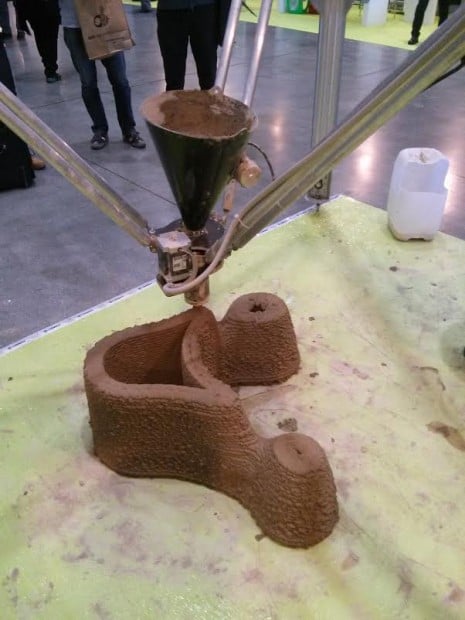The goal of Italy-based WASP (World’s Advanced Saving Project) is to enable “zero mile” homes, 3D printed with local materials. Now they seem to have created the hardware to do so.
The project has been gradually working towards this result, beginning with the development of simple opensource 3D printing gear, moving to large delta-based 3D printers suitable for 3D printing clay, to much larger delta 3D printers – the most recent, the “WASP BigDelta”, being an incredible 12m tall.
The key feature developed this year and just released is their new clay extruder, which overcomes several issues in previous iterations. The highlights:
The new extruder is now capable of retraction. This means they’ve moved from a “continuous flow” method to a “precise flow control”. Retraction is essential if extrusion is to temporarily stop while extruder movement takes place. In other words, far more complex structures can now be attempted.
Low maintenance features have been added: the extruder is self=cleaning and can be assembled and disassembled very quickly.
The extruder’s nozzle can be rotated during extrusion, meaning that layers have better adhesion and consequently the prints are stronger. (See video)
Printing now takes far less energy; the new extruder lets material fall rather than using more energy to “push” the clay through.
What’s next? Here’s what they say:
Many people ask us when we’re going to built the first house. Now we have all the conditions and premises to the crucial jump. We think we have played our role, we projected (and in a few time we will build) a printer to erect houses. There are the right conditions. Then, other factors will enter the game, we need other subjects: institutions, municipalities, territories. Sardinia Research (Sardegna Ricerche, is a local institution) and Iglesias municipality are interested in the project. For sure it will be a team work. Others équipes will print houses, we will keep our research to emprove the system. This is our extraordinary, charming and challenging “conviction”.
So, we now apparently have the technology to 3D print homes using an inexpensive, open source technology. It’s only going to be a matter of time before this appears in locales where housing is required. The next question will surely be, “what are the best 3D home designs for this technology?”
Via WASP


